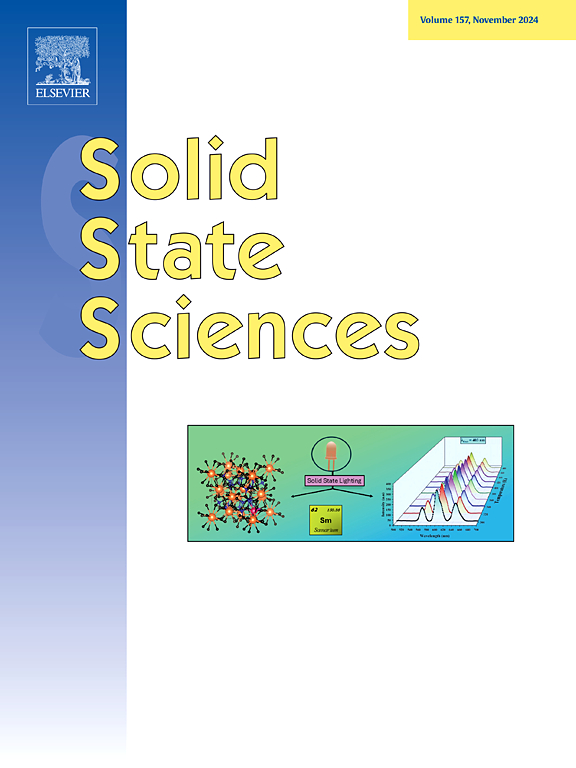Waste biomass-derived N, S-codoped porous carbon flakes for high energy density asymmetric supercapacitors
IF 3.3
3区 化学
Q2 CHEMISTRY, INORGANIC & NUCLEAR
引用次数: 0
Abstract
Production of affordable energy devices requires the fabrication of cheap electrode materials with high energy and power densities and long cycle stability. Carbon materials retrieved from waste biomass in sugar mills have attracted considerable attention because of their low-cost and environmental benefits. But their low capacitance and poor rate-capability still remain serious issues. Herein, activated N, S-codoped porous carbon (NS-WSB-AC) was synthesized via simultaneous in-situ and gas-phase heteroatom doping, carbonization, and KOH + CO2 activation processes, where waste sugarcane bagasse (WSB) as a carbon source, hydrazine as a nitrogen source and H2S gas as a sulfur source were used. As-prepared NS-WSB-AC exhibited a high specific surface area of 2455.6 m2/g, a large mesoporosity of 0.4784 cm3/g, and a substantial heteroatom content (19.45 atom%). Because of these features, the NS-WSB-AC achieved a high specific capacitance of 405.67 F/g at 0.2 A/g with remarkable rate-performance (72.7 % at 5 A/g) in a 6 M KOH electrolyte. However, the NS-WSB-AC demonstrated outstanding cycling stability (98.7 % capacitance retention after 10000 cycles) in a 1 M Na2SO4 electrolyte. The NS-WSB-AC//WSB-AC ASC device with KOH electrolyte exhibited a superior energy density of 54.73 Wh kg−1 at a power density of 207.8 W kg−1 when compared to the Na2SO4-based device.

用于高能量密度非对称超级电容器的废弃生物质衍生N, s共掺杂多孔碳片
生产经济实惠的能源设备需要制造具有高能量和功率密度以及长周期稳定性的廉价电极材料。从糖厂废生物质中回收的碳材料因其低成本和环境效益而引起了人们的广泛关注。但它们的低电容和低倍率性能仍然是严重的问题。本文以废甘蔗渣(WSB)为碳源,肼为氮源,H2S气体为硫源,通过原位和气相杂原子掺杂、炭化和KOH + CO2同步活化工艺合成了活化的N, s共掺杂多孔碳(NS-WSB-AC)。制备的NS-WSB-AC具有2455.6 m2/g的高比表面积、0.4784 cm3/g的大介孔和19.45原子%的高杂原子含量。由于这些特点,NS-WSB-AC在0.2 a /g时获得了405.67 F/g的高比电容,在6 M KOH电解液中具有显著的倍率性能(5 a /g时72.7%)。然而,NS-WSB-AC在1 M Na2SO4电解液中表现出出色的循环稳定性(10000次循环后电容保持率为98.7%)。采用KOH电解液制备的NS-WSB-AC//WSB-AC ASC器件功率密度为207.8 W kg - 1,能量密度为54.73 Wh kg - 1,优于na2so4器件。
本文章由计算机程序翻译,如有差异,请以英文原文为准。
求助全文
约1分钟内获得全文
求助全文
来源期刊

Solid State Sciences
化学-无机化学与核化学
CiteScore
6.60
自引率
2.90%
发文量
214
审稿时长
27 days
期刊介绍:
Solid State Sciences is the journal for researchers from the broad solid state chemistry and physics community. It publishes key articles on all aspects of solid state synthesis, structure-property relationships, theory and functionalities, in relation with experiments.
Key topics for stand-alone papers and special issues:
-Novel ways of synthesis, inorganic functional materials, including porous and glassy materials, hybrid organic-inorganic compounds and nanomaterials
-Physical properties, emphasizing but not limited to the electrical, magnetical and optical features
-Materials related to information technology and energy and environmental sciences.
The journal publishes feature articles from experts in the field upon invitation.
Solid State Sciences - your gateway to energy-related materials.
 求助内容:
求助内容: 应助结果提醒方式:
应助结果提醒方式:


